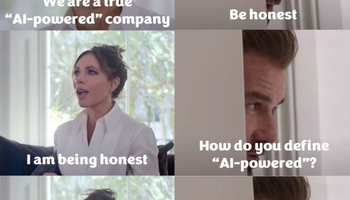The Reskilling Illusion: When AI Transformation Means "You're Fired"
Managing Partner

The Reskilling Illusion: When AI Transformation Means "You're Fired"
There's a better way to do AI transformation. But first, you need to see the crap that’s actually happening. Accenture just fired 11,000 employees who couldn't adapt to AI. Now they're hiring 80,000 consultants to tell YOUR company how to handle AI transformation.
If Accenture couldn't reskill 11,000 people they directly employed, why and how would they succeed with yours?
Here's What They're Getting Wrong
The current playbook is broken. Fire workers, deploy AI agents, hope for transformation. Except 40% of those AI projects get canceled before production (Gartner, June 2025). That's not transformation, that's expensive theater with documented failure rates.
The pattern is clear:
- Companies declare employees "not viable for reskilling"
- Deploy AI agents with hidden costs nobody calculated
- Create security vulnerabilities through integrations they don't understand
- Watch 40% of projects die before reaching production
- Blame technology instead of admitting the strategy was flawed from the start
This is the wrong approach. Here's why it keeps failing.
The Admission Nobody Was Supposed to Hear
Julie Sweet, Accenture's CEO: "We are exiting on a compressed timeline people where reskilling, based on our experience, is not a viable path for the skills we need."
Translation? We gave up on our own people.
Accenture spent $615 million in severance this quarter—part of an $865 million restructuring. They're selling a $5.1 billion AI transformation story while declaring the people they hired, trained, and evaluated are "not viable" for reskilling.
But they'll transform YOUR workforce. Using AI agents that have a 40% chance of being canceled before production.
The better way? Actually invest in transformation before you fire the people who understand your business.
The numbers Reveal the Failure Pattern
- 95% of AI pilots failing (MIT)
- 80% AI project failure rate (RAND)
- 40% of agentic AI projects canceled before production (Gartner)
- 85% of AI projects fail due to data issues (Forbes)
- 10% of AI use cases make it past pilot stage (McKinsey)
- 71% of companies use gen AI, yet most report zero bottom-line impact (McKinsey)
These aren't predictions. These are warnings everyone's ignoring. Consultants charge millions to deploy agents with documented 40% cancellation rates while telling you the problem is your workforce's inability to adapt.
The real problem? Leadership choosing speed over strategy, margins over people, and billion-dollar narratives over billion-dollar failure rates.
What The Prophets Aren't Telling You
Salesforce: Marc Benioff dismissed AI job displacement concerns at the AI for Good Summit. 60 days later? He revealed Salesforce cut customer support from 9,000 to 5,000 employees. That's 4,000 jobs—gone. AI handles 50% of customer conversations now, up from zero last year.
Then in August 2025, over 700 organizations had Salesforce data stolen through Salesloft's Drift AI chat agent—the very tool deployed to replace those 4,000 workers.
The lesson: Cutting security staff while deploying AI integrations you don't understand creates attack vectors that cost more than the labor savings.
Amazon: Andy Jassy's June 2025 memo: "We will need fewer people doing some of the jobs being done today. In the next few years, we expect this will reduce our total corporate workforce as we get efficiency gains from using AI." Amazon already cut 27,000 jobs. Jassy's advice to the remaining workforce? "Figure out how to get more done with scrappier teams."
Translation: We're optimizing for margins, not transformation. You're on your own.
Microsoft: GitHub Copilot writes 30% of new code. Microsoft cut 15,000 jobs in 2025 while posting $70.1 billion in revenue—a 13% increase. That's not a struggling company. That's choosing margins over people.
IBM: Cut 8,000 HR employees and replaced them with an AI chatbot called AskHR. Then joined the AI-Enabled ICT Workforce Consortium committed to "training 95 million individuals."
The pattern is clear: Fire your own people, then sell "transformation" to others.
The Hidden Costs Killing 40% of AI Projects (And Why Nobody Told You)
Here's what consultants don't mention when selling you AI transformation: Evaluation costs balloon. Each eval run costs $0.01-$0.10 per sample using GPT-4. Top agents require 100+ iterations per development cycle. Mid-sized projects hit thousands in evaluation costs alone.
Infrastructure explodes. Real example: e-commerce firm's agentic supply chain optimizer jumped from $5K/month in prototyping to $50K/month in staging. That's 10x cost explosion nobody budgeted.
Agent inference devours budgets. High-performing agents consume 10-50x more tokens per task due to iterative reasoning loops. Complex agents with tool-calling use 5-20x more tokens than simple chains.
Data quality kills deployments. In RAG pipelines, noisy embeddings reduce retrieval accuracy 20-30%, causing inference retries and token consumption spikes. Expensive cleanup wasn't in the business case.
Security vulnerabilities compound. August 2025: 700+ organizations breached through Drift AI OAuth tokens. Companies cut security staff, then deploy AI integrations creating attack vectors they don't understand. Average data breach cost: $4 million (IBM, 2024).
This is why Gartner predicts 40% cancellation rate. Not because technology doesn't work. Because "the real cost and complexity of deploying AI agents at scale" makes them economically unviable when you don't calculate true costs upfront.
The better approach: Calculate full costs before deployment. Secure integrations before rollout. Acknowledge that institutional knowledge can't be recreated with prompts.
What Leadership Should Be Demanding (The Right Questions)
Before hiring armies of consultants who declared 11,000 employees "not viable," demand actual data:
- Show us your own reskilling success stories. How many employees did you successfully transition versus fire? If Accenture couldn't reskill people they directly employed, why would they succeed with yours?
- Show us your agentic AI projects that made production. What percentage versus the 40% industry cancellation rate? If you're selling transformation, prove you can deliver it.
- Show us your actual costs. How did evaluation, infrastructure, data quality, and security costs compare to initial projections? If costs jumped 10x from prototype to staging, that's not transformation—that's budget explosion.
- Show us your security track record. How many incidents resulted from AI integrations you deployed? If Salesforce cut 4,000 workers then suffered a breach affecting 700+ organizations, where's the success model?
- Explain the McKinsey paradox. If you project trillions in AI value while your own surveys show most companies see zero bottom-line impact and fewer than 10% of use cases survive pilot stage, why should we trust projections over reality?
The better way: Demand proof, not promises. Require data, not narratives. Insist on transparency about failure rates before committing millions.
The Bottom Line: There's a Better Path Forward
130,981 tech workers lost jobs across 434 layoff events by July 2025. Companies are profitable—Microsoft up 13%, Amazon spending $100 billion on AI in 2025.
This isn't about survival. It's about choosing the wrong strategy.
The current approach delivers:
- Cost discipline disguised as transformation
- Expanded attack surfaces security teams can't defend
- Hidden technical costs making 40% of projects economically unviable
- Evaluation overhead ballooning budgets by thousands
- Infrastructure costs jumping 10x from prototype to staging
- Security vulnerabilities costing millions to remediate
The better approach acknowledges:
- Your employees deserve investment, not being labeled "not viable"
- Your security teams need resources before you deploy OAuth vulnerabilities
- Your finance teams need full cost projections, not surprise 10x explosions
- Your board needs to know 40% of these projects will be canceled before production
- Institutional knowledge can't be recreated with prompts
- True transformation requires strategy, not just technology replacement
Here's What Right Looks Like
Calculate before you commit. Full cost analysis including evaluation overhead, infrastructure scaling, data quality cleanup, and security hardening. If consultants can't provide this, they're selling theater.
Secure before you deploy. Every AI integration is a potential attack vector. The $4 million breach costs more than keeping experienced security staff.
Invest before you fire. Transformation means developing institutional knowledge alongside new capabilities, not destroying one to chase the other.
Acknowledge failure rates. If 40% of projects get canceled, that's not a technology problem—it's a strategy problem. Plan accordingly.
Demand proof from consultants. If they couldn't transform their own organizations without mass layoffs and security breaches, why would they succeed with yours?
The Choice
The AI era will reveal which companies meant what they said and which ones were performatively managing optics until layoffs could be blamed on technology.
The security breaches will reveal who deployed responsibly and who prioritized speed over safety.
The project cancellations will reveal who calculated true costs and who believed trillion-dollar narratives without reading the fine print about 40% failure rates.
Your workforce is watching. Your threat actors are watching. Your shareholders will be watching when that "agentic AI project" gets canceled after burning millions.
You can follow the broken playbook—fire workers, deploy agents with 40% cancellation rates, discover hidden costs too late, create security vulnerabilities, then blame technology when it fails.
Or you can choose the better path: Calculate true costs. Invest in people and technology together. Secure before you scale. Demand proof before spending millions on consultants who couldn't transform their own organizations.
Nobody's buying the reskilling rhetoric anymore. But there's still time to choose a strategy that actually works.
The question is: Will you?
Related Articles

We were doing just fine.
ChatGPT was released not three years ago. Think about that.
Nov 18, 2025